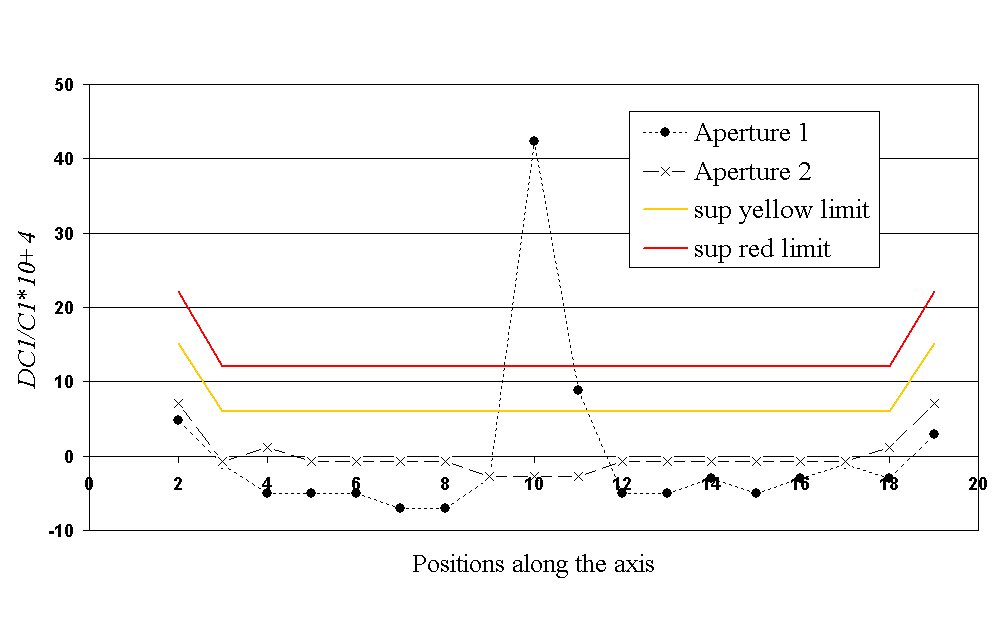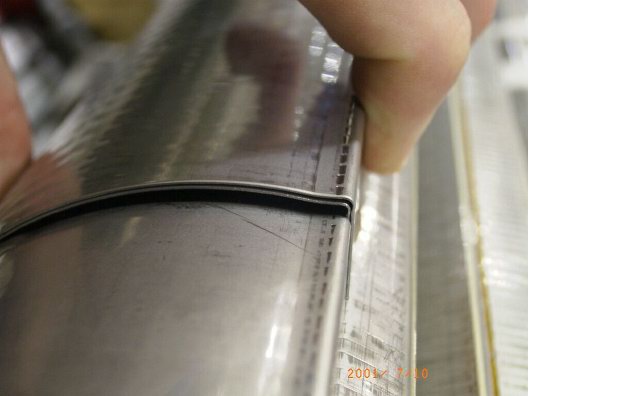Sections:
Divers:
.
![]()
The Field Quality Crisis Unit of the LHC main dipoles production |

|
The double coil protection sheet in collared coil 2002
![]() July 16th and 17th 2001,
CERN. Magnetic measurements of collared coil 2002 carried out by A.
Musso on 16th July 2001 show an anomaluos spike in the main field of around
40 positive units in position 10 of aperture 1 (middle of the collared coil,
see file). A new measurement is asked by E. Todesco in the critical positions,
giving the same results (17th July 2001).
July 16th and 17th 2001,
CERN. Magnetic measurements of collared coil 2002 carried out by A.
Musso on 16th July 2001 show an anomaluos spike in the main field of around
40 positive units in position 10 of aperture 1 (middle of the collared coil,
see file). A new measurement is asked by E. Todesco in the critical positions,
giving the same results (17th July 2001).
![]() July, 17th 2001, CERN - the unity of crisis is activated. Presents: C. Wyss,
L. Rossi, W. Scandale, M. Modena, E. Todesco, G. Spigo, A. Musso, J. Vlogaert.
The defect is concentrated in position 10, where one observes +40 units of
main field, -25 units of b2, +6 of b3. Smaller variations are observed in
a1 and a2. Position 9 and 11 feature lower anomalies.
July, 17th 2001, CERN - the unity of crisis is activated. Presents: C. Wyss,
L. Rossi, W. Scandale, M. Modena, E. Todesco, G. Spigo, A. Musso, J. Vlogaert.
The defect is concentrated in position 10, where one observes +40 units of
main field, -25 units of b2, +6 of b3. Smaller variations are observed in
a1 and a2. Position 9 and 11 feature lower anomalies.
From a point of view of beam dynamics the defect is negligible since
the average values are not strongly affected. In the specification, only
windows for average values are given and therefore the magnet should be
accepted. Indeed, the defect indicates a bad assembly procedure or a faulty
component. It is not clear if this defect could affect quench performaces.
Final decision: the collared coil is sent back to the manufacturer for
decollaring.

![]() July, 20th 2001 - Manufacturer 2. The collared coil is decollared. A double
coil protection sheet is found in the central part of aperture 1. The
second coil protection sheet is taken out and the magnet is recollared.
July, 20th 2001 - Manufacturer 2. The collared coil is decollared. A double
coil protection sheet is found in the central part of aperture 1. The
second coil protection sheet is taken out and the magnet is recollared.

![]() July, 22th 2001 - Manufacturer 2. Warm magnetic measurements of the re-collared
coil show that the anomalous spikes in the central part of the magnet have
disappeared, see
file).
Only a small mark is still visible in b2 (around -4 units).
July, 22th 2001 - Manufacturer 2. Warm magnetic measurements of the re-collared
coil show that the anomalous spikes in the central part of the magnet have
disappeared, see
file).
Only a small mark is still visible in b2 (around -4 units).
![]() Simulations carried out by P. Ferracin with ANSYS and Roxie show a good
agreement with the measured effect. In particular, the ANSYS result shows that
the outer layer rigidly moved inward of the coil protection sheet thickness
(0.5 mm), whilst the inner layer underwent a smaller radial displacement.
Results are summarized in the Master Thesis of S. Pauletta, pg. 103.
Simulations carried out by P. Ferracin with ANSYS and Roxie show a good
agreement with the measured effect. In particular, the ANSYS result shows that
the outer layer rigidly moved inward of the coil protection sheet thickness
(0.5 mm), whilst the inner layer underwent a smaller radial displacement.
Results are summarized in the Master Thesis of S. Pauletta, pg. 103.
![]() The magnet underwent electrical problem with quench heaters that were shown
to be not related to the double coil protection sheet accident.
The magnet underwent electrical problem with quench heaters that were shown
to be not related to the double coil protection sheet accident.
![]() This accident showed that it is very difficult to define a priori acceptance
ranges for field quality. The specification has been later changed in the
following way: acceptance ranges are only indicative, and if CERN can prove
that the magnet has a faulty component or that a wrong assembly procedure has
been followed through magnetic measurements, the magnet can be refused.
This accident showed that it is very difficult to define a priori acceptance
ranges for field quality. The specification has been later changed in the
following way: acceptance ranges are only indicative, and if CERN can prove
that the magnet has a faulty component or that a wrong assembly procedure has
been followed through magnetic measurements, the magnet can be refused.
![]()
Content- Ezio
Todesco - Mars 2001